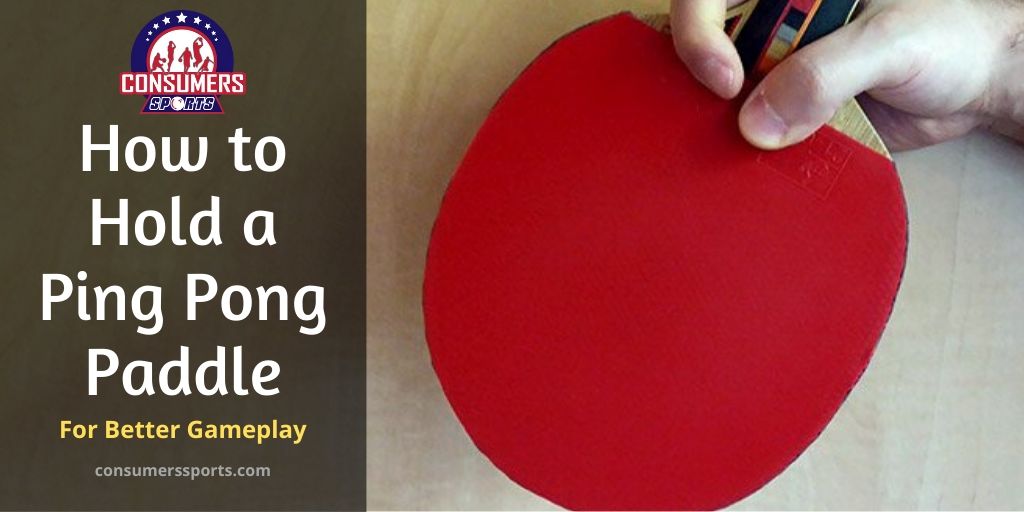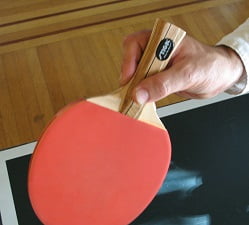Most newbies in the Ping Pong game don’t realize that there is the right method to hold a ping pong paddle. And No! Getting the best ping pong paddle in the entire world does not mean you’ll be able to hold a ping pong paddle well. You have to master the techniques of conducting a ping pong paddle. Why? It dictates the quality of your performance at any Ping Pong game.
Note: learning the right mode to hold a ping pong paddle does not automatically make you a great player. It only gives you more power plus control over your stroke and the ball.
So, whether you are a beginner or a ping pong performer who never knew that there is the right technique to hold a ping pong paddle, keep reading. In this article, we dig deeper into the art of holding a Ping Pong Paddle the right way.

Table of Contents
TYPES OF PING PONG GRIP
First off, there exist two significant types of grip in the Ping Pong game. They are the Shakehand grip and the Penhold grip.
The Shakehand Grip
While some people like to save the best for last, we prefer to start with the best. Most ping pong players around the world adopt this style of ping pong paddle grip. It is popular among westerners as they tend to play with this grip. However, ping pong players across Europe and Asia have also adopted this grip technique. Perhaps, the reason is that it is straightforward to use. It also gives players control over the ball.
This grip technique gets its name from how it works. From observation, the notable shakehand grip mimics the handshake technique. How? Just as the fingers wrap around another person’s hand in a handshake, it wraps around the ping pong handle in the shakehand grip technique.

While trying out this technique, ensure that you place your fingers in a way that enables you to try different ping pong techniques like the forehand and backhand flick, drive, etc. In other words, flexibility is the goal of getting the paddle grip correctly. Start by gently pinching the paddle head with your index finger and your thumb. Then, wrap your middle finger, ring finger, and your pinky around the paddle handle. For your wrist to freely swing the paddle while you play, the pressure is applied on the index finger and the thumb, not on your other fingers. More so, sportsmen often advise that you should hold the paddle loosely than firmly.
There survive two types of shakehand grip techniques, namely the Shallow Shakehand Grip and the Deep Shakehand Grip. The difference between these two is pronounced in how you place your thumb on the paddle.
- It allows for flexibility. In other words, rather than switch grips while playing, the shakehand grip makes it possible for you to play with one hand while using different playing techniques.
- It is a universal ping pong grip. Perhaps it is because it is the most comfortable ping pong grip to learn.
- Helps with accuracy while playing
- The shallow shakehand makes it easy for you to spin the ball.
- It is a universal grip method that makes it the widely accepted grip technique by coaches and professional players.
- It is a typical kind of grip. As a result, your opponent could predict your move.
- Its crossover point is weak
The Penhold Grip
This grip technique lives up to its name. Called a Penhold grip, it mimics the method used in holding a pen. Unlike the shakehand grip, Penhold grip originated among Asian ping pong players. However, it has spread like wildfire into the west, as many western players adopt this technique. Different players that adopt penhold grip technique modify this technique to suit their hand positions. Just like the Shakehand grip technique, players who use this technique well can exert full control on the ball.
Using a penhold grip technique begins with circling the index finger and the thumb around the paddle handle. On the backend of a paddle, the rest of your fingers can either assume a flat or curved position. The handle of the paddle is shorter than the paddle used for the Shakehand grip technique.

There are three types of Penhold grip technique. They include the Korean/Japanese Penhold grip, the Chinese grip technique, and the Reverse-backhand grip. In the Chinese penhold grip, players hold the paddle in a way that it faces downwards. If you like staying close to the table, you could try out this technique.
Also, the fingers at the back part of that paddle assume a curved shape. In the Japanese/Korean Penhold grip, players make their ring finger, middle finger, and pinky assume a straight position at the back part of the paddle.
The hand position behind the paddle is the difference between the distinguished Chinese penhold grip and the Japanese/ Korean Penhold grip.
Penhold grip technique only allows players to use one side of the paddle while playing. Players can use the front side of the paddle to showcase their playing techniques. However, the Reverse-backhand penhold grip technique allows players to use both the front side and the backside of the paddle while playing.
- It is more flexible compared to the celebrated Shakehand grip technique.
- It allows you to exert full control over the ball.
- Your opponent would have a hard time predicting your moves.
- It’s not the best choice for beginners, as it is challenging to learn.
There are other types of Ping Pong grip that some players use. But the Ping Pong Tournament only approves a few grip techniques. Some of the grip techniques that exist include the Seemiller grip, the V-grip, Hammer grip, etc.
Conclusion
In conclusion, beginners should start their ping pong journey with the Shakehand grip technique. It is easy to learn, and you would quickly get comfortable with it. Also, holding the paddle well is very crucial to the success of any Ping Pong player. Although it doesn’t instantly make you a pro, it gets you off to a smooth start.

